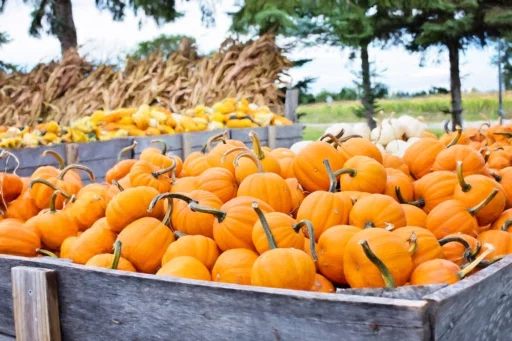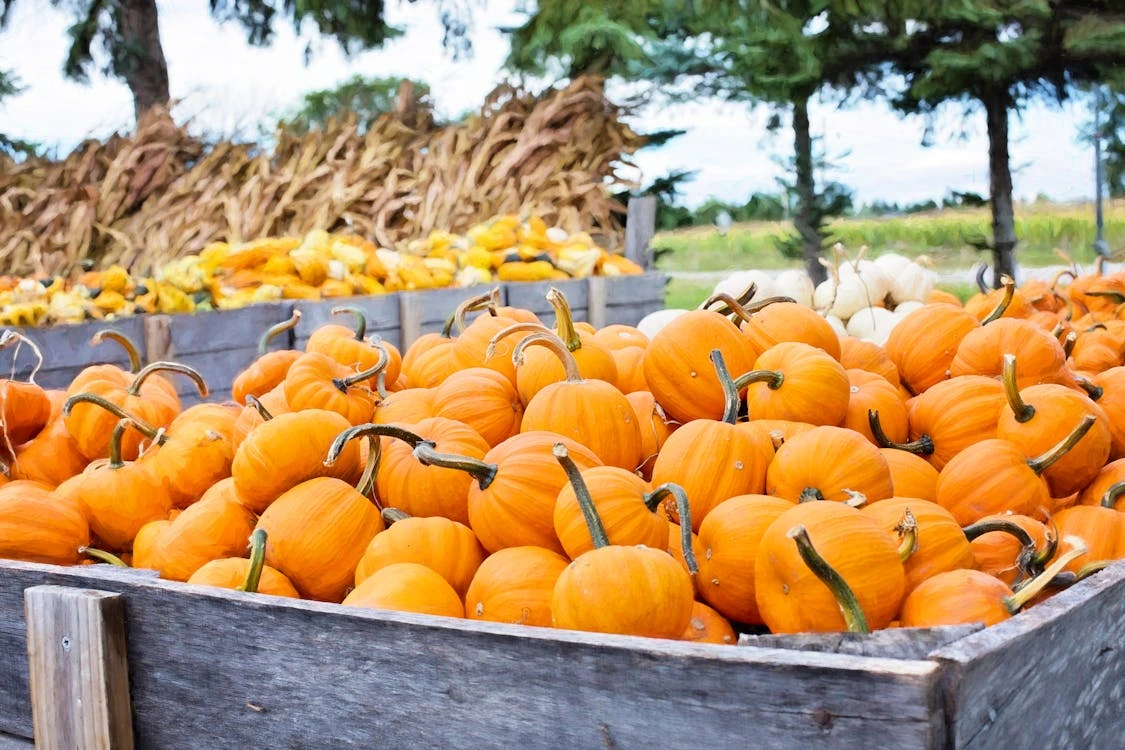Pumpkin, widely enjoyed in Canada during the fall season, is more than just a festive ingredient; it is a powerhouse of nutrition.
Table of Contents:
- 🍽️ Nutrition Facts of Pumpkin
- ❤️ Health Benefits of Pumpkin
- 🤒 Adverse Effects of Pumpkin
- 📅 Best Season for Pumpkin
- 🥘 How to Prepare Pumpkin
Rich in vitamin A, pumpkin supports eye health and boosts the immune system, while its high fibre content promotes digestive health and heart wellness. Low in calories and packed with antioxidants like beta-carotene, pumpkin helps protect the body from oxidative stress and inflammation.
Whether used in soups, stews, or baked goods, pumpkin offers a delicious way to enhance both flavour and nutrition in your meals.
🍽️ Nutrition Facts of Pumpkin
Pumpkin, a beloved seasonal vegetable in Canada, is not only a versatile ingredient in both sweet and savory dishes but also offers an impressive nutritional profile. Here’s a breakdown of the nutrients found in pumpkin, listed by the quantity of each component:
- Carbohydrates: The most abundant nutrient in pumpkin is carbohydrates, which are primarily in the form of natural sugars and fiber. These carbohydrates provide energy, while the fiber content supports healthy digestion and helps regulate blood sugar levels.
- Vitamins: Pumpkin is exceptionally rich in vitamin A, providing more than 200% of the recommended daily intake in just one cup of cooked pumpkin. This is mainly due to its high beta-carotene content, which the body converts to vitamin A, essential for eye health, immune function, and skin integrity. Pumpkin also contains smaller amounts of vitamin C, which supports immune health and collagen production, and vitamin E, an antioxidant that helps protect cells from oxidative damage.
- Minerals: In terms of minerals, pumpkin provides potassium, which helps regulate blood pressure and supports heart health. It also contains magnesium, important for muscle function, and small amounts of iron and calcium.
- Antioxidants: Pumpkins are packed with antioxidants, including beta-carotene, lutein, and zeaxanthin. These compounds help protect the body from oxidative stress and may reduce the risk of chronic diseases, such as heart disease and certain cancers.
For Canadians looking to boost their intake of nutrient-rich foods, pumpkin is an excellent choice. Whether roasted, pureed into soups, or baked into desserts, pumpkin provides a flavorful and nutritious addition to the diet, offering numerous health benefits while being low in calories.
❤️ Health Benefits of Pumpkin
Pumpkin, a nutrient-rich vegetable commonly enjoyed in Canada, offers a variety of health benefits that support different parts of the body. Packed with vitamins, minerals, and antioxidants, pumpkin can improve overall wellness in several key areas.
- Eye Health: Pumpkin is exceptionally high in beta-carotene, which the body converts into vitamin A. This vitamin is crucial for maintaining good vision, particularly in low-light conditions. Consuming pumpkin can help prevent conditions such as night blindness and age-related macular degeneration.
- Immune System: The high levels of vitamin A and vitamin C in pumpkin boost the immune system. Vitamin A strengthens the body’s defences against infections, while vitamin C supports the production of white blood cells, which fight off harmful bacteria and viruses.
- Skin Health: The antioxidants in pumpkin, including beta-carotene and vitamin C, help protect the skin from damage caused by the sun and environmental factors. These nutrients also promote collagen production, which helps maintain skin elasticity and reduces signs of aging, such as wrinkles and fine lines.
- Heart Health: Pumpkin is rich in potassium, which plays a key role in regulating blood pressure and maintaining heart health. Additionally, its high antioxidant content helps reduce inflammation and oxidative stress, both of which are linked to heart disease. The fibre in pumpkin also helps lower cholesterol levels, further supporting cardiovascular health.
- Digestive Health: The dietary fibre in pumpkin aids digestion by promoting regular bowel movements and preventing constipation. A fibre-rich diet also supports a healthy gut microbiome, which is essential for overall digestive health.
- Bone Health: Pumpkin contains magnesium, a mineral that is vital for maintaining strong bones. Magnesium helps with the absorption of calcium, which is necessary for bone density and strength, reducing the risk of osteoporosis and fractures.
By incorporating pumpkin into your diet, you can enhance the health of various parts of the body, from your eyes to your heart and bones. Whether enjoyed in soups, baked goods, or roasted as a side dish, pumpkin is a delicious way to support overall well-being.
🤒 Adverse Effects of Pumpkin
Pumpkin, while highly nutritious and generally safe for most people, can have potential adverse effects if consumed in excess or by individuals with certain sensitivities. For Canadians considering regular consumption of pumpkin, it is important to be aware of these potential issues.
- Digestive Issues: Pumpkin is rich in fibre, which is beneficial for digestion. However, consuming large quantities can cause gastrointestinal discomfort such as bloating, gas, or diarrhoea, especially for individuals who are not accustomed to a high-fibre diet. Moderation is key to avoiding these issues while still gaining the digestive benefits of pumpkin.
- Vitamin A Overdose: Pumpkin is high in beta-carotene, which the body converts to vitamin A. While this is generally beneficial, excessive intake of vitamin A over time can lead to hypervitaminosis A, a condition that can cause symptoms like headaches, dizziness, nausea, and, in severe cases, liver damage. However, it is important to note that the body regulates beta-carotene differently than preformed vitamin A, making it less likely to cause toxicity unless consumed in extreme amounts over a prolonged period.
- Drug Interactions: Pumpkin is a good source of potassium, which is beneficial for heart health. However, individuals taking certain medications, such as beta-blockers or potassium-sparing diuretics, may need to monitor their potassium intake closely. Consuming large amounts of pumpkin could lead to elevated potassium levels, which may interfere with these medications and potentially cause complications such as hyperkalemia, a condition that affects heart function.
- Potential Allergies: Although rare, some individuals may be allergic to pumpkin. Symptoms of an allergic reaction may include itching, swelling, or difficulty breathing. If you experience any of these symptoms after consuming pumpkin, it is important to seek medical advice. Those with known allergies to other members of the gourd family, such as squash or cucumbers, should be cautious when introducing pumpkin into their diet.
For most Canadians, pumpkin can be safely enjoyed as part of a balanced diet. However, it is important to consume it in moderation and be mindful of any potential allergies or interactions with medications. Consulting a healthcare provider is always recommended if there are concerns about incorporating pumpkin into your diet regularly.
📅 Best Season for Pumpkin
Pumpkin, a beloved vegetable in Canadian kitchens, is best purchased and enjoyed during its peak season, though it can be stored and used long after its harvest. Knowing when to buy and how to store pumpkin properly ensures you can enjoy its rich flavour and nutritional benefits throughout the colder months.
- Best Season to Purchase: In Canada, the ideal time to purchase fresh pumpkins is in the fall, typically from late September through November. This is when pumpkins are harvested locally, offering the freshest and most flavourful options. During these months, pumpkins are widely available at grocery stores, farmers’ markets, and even local pumpkin patches. Choosing pumpkins in season ensures they have ripened fully and will provide the best texture and taste for cooking and baking.
- Selecting the Best Pumpkins: When shopping for pumpkins, look for ones that feel heavy for their size, with firm, smooth skin free of soft spots, cracks, or blemishes. The stem should be intact and sturdy, which indicates freshness. Smaller pumpkins, often referred to as “sugar” or “pie” pumpkins, are sweeter and more tender, making them ideal for cooking compared to larger varieties typically used for decoration.
- Storing Pumpkins: Uncut pumpkins can be stored in a cool, dry place, such as a basement, pantry, or cellar, for several months. Proper storage conditions include temperatures between 10 and 15 degrees Celsius, which help prevent them from spoiling. Avoid placing pumpkins in direct sunlight or near heat sources, as this can cause them to ripen too quickly. When stored correctly, pumpkins can last up to three months or longer.
By purchasing pumpkins during their peak season and storing them properly, Canadians can extend the enjoyment of this nutrient-dense vegetable well beyond autumn. Whether used in pies, soups, or roasted dishes, pumpkin adds a rich flavour and a boost of nutrition to any meal.
🥘 How to Prepare Pumpkin
Pumpkin, a versatile and nutritious ingredient, can be easily prepared and cooked at home to create a variety of dishes. Whether roasted, pureed, or used in baking, proper preparation is key to bringing out its rich, earthy flavour. Here is a guide to preparing and cooking pumpkin for Canadian home cooks.
- Preparation: Start by thoroughly washing the pumpkin to remove any dirt from the skin. Using a sharp, sturdy knife, slice off the stem and bottom to create a flat base. Stand the pumpkin upright and carefully slice it in half. Scoop out the seeds and fibrous strands with a spoon. The seeds can be saved and roasted for a healthy snack. Depending on the recipe, you can either peel the skin with a vegetable peeler or leave it on if you plan to roast the pumpkin.
- Roasting: Roasting pumpkin enhances its natural sweetness and is one of the most popular methods for cooking it. Preheat your oven to 200°C. Cut the pumpkin into cubes or wedges, leaving the skin on if desired. Toss the pieces with olive oil and season with salt, pepper, and any additional herbs or spices you like, such as rosemary or cinnamon. Arrange the pumpkin on a baking sheet in a single layer and roast for 25 to 35 minutes, turning halfway through, until the flesh is tender and caramelized. Roasted pumpkin can be served as a side dish, added to salads, or used in grain bowls.
- Boiling: For soups or purees, boiling or steaming pumpkin is a quick and easy method. After cutting and peeling the pumpkin, chop it into cubes and place them in a large pot of boiling water. Cook for 10 to 15 minutes, or until the pumpkin is tender. Drain and use the cooked pumpkin in soups, mashes, or as a filling for baked goods.
- Steaming: Steaming is a gentler method that helps retain more of the pumpkin’s nutrients. Place peeled and cubed pumpkin in a steamer basket over simmering water. Cover and steam for 15 to 20 minutes, or until the pumpkin is fork-tender. This method is ideal if you plan to puree the pumpkin for soups, sauces, or baby food.
- Pureeing: Pumpkin puree is a versatile base for soups, sauces, and baked goods. After roasting, boiling, or steaming, transfer the cooked pumpkin to a blender or food processor. Blend until smooth, adding a little water or broth if necessary for a smoother consistency. Pumpkin puree can also be frozen in portions for later use.
By following these methods, Canadians can enjoy the rich flavour and nutritional benefits of pumpkin in a variety of ways. Whether roasted, steamed, or pureed, pumpkin can easily be incorporated into soups, salads, desserts, or side dishes, making it a versatile addition to any meal.

